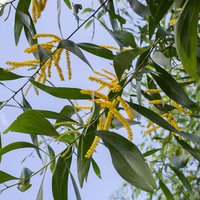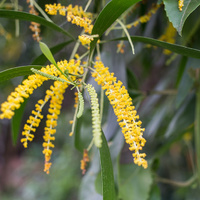Common name: Earleaf Acacia
Other common names: Black Wattle, Brown Salwood, Darwin Black Wattle, Earpod Wattle, Tan Wattle
Description
Earleaf Acacia is a woody legume native to tropical Australia and Papua New Guinea.
It is highly variable in the wild, from shrubs 2 to 5 m (7 to 16 ft) tall on exposed coastal sites to large timber trees reaching up to 30 m (100 ft) under favourable conditions. Grown in gardens, it is typically a medium-sized tree 10 to 15 m (30 to 50 ft) tall. Trees on good soil with adequate moisture develop a straight trunk with smooth, greyish bark becoming fissured with age and a large, heavily branched, rounded crown.
Leaves are long, sickle-shaped, deep green and densely arranged, casting a deep shade.
Flowers are bright yellow, small and held in showy finger-like clusters. Flowering appears to coincide with the start of the rainy season, which is spring to summer in most tropical areas, including its native range.
The seedpods have an unusual, curled ear shape, leading to the tree being named 'Earleaf Acacia' and 'Earpod Wattle'. They mature on the tree, turning brown and then split open to release their seed, which dangle from a string-like aril attached to the inside of the seedpod.
Use
Earleaf Acacia is cultivated for various environmental services, including land rehabilitation, erosion prevention and soil improvement - due to its nitrogen-fixing ability enabling it to grow on a wide range of nutrient-poor soils - and for its good tolerance to drought, flooding and salty conditions.
It produces a medium-weight wood in the 600 to 750 kgs per cubic meter (37 to 46 lbs per cubic ft) range, with low to moderate natural resistance to rot and decay, making it primarily suitable for indoor and above-ground use.
The sawn timber reveals attractively figured, light-brown to dark-red heartwood, which is used above all for making fine furniture and cabinets. Small diameter logs and branchwood pieces are cut for firewood and charcoal, for which the tree is widely cultivated in agroforestry systems. They are also cut for poles and posts, woodcraft, including turnery, and are an excellent source of pulpwood to manufacture paper and paper products.
It is widely cultivated as a street tree in Southeast Asia for its fast growth, shade, and its showy flowers and foliage.
Climate
Grows naturally in sub-humid to humid tropical lowland climates, generally areas with annual lows of 17 to 25°C, annual highs of 27 to 35°C, annual rainfall of 700 to 2000 mm and a dry season of 3 to 8 months. However, it grows fastest and reaches its best development as a timber tree in areas with annual rainfall of 1200 to 5000 mm.
Growing
New plants usually start from seed, which remain viable for up to two years under dry, air-tight storage. It performs well on free- to slow-draining clay, loam and sand soils of an acid-to-alkaline nature, generally with a pH of 4.5 to 8.5, and on sites with full to partial sun exposure. It has good tolerance to salt and seasonal flooding and can fix nitrogen from the air, making it productive on nutrient-poor soils.
Problem features
It is recorded as a weed species in some countries and is assessed as a high weed risk species for Hawaii by the Hawaii Pacific Weed Risk Assessment (HPWRA) project. Seed-eating birds are reported as the main contributors to its spread beyond cultivation.
The branches are brittle and susceptible to wind damage, increasing the risk of them falling and causing personal injury or damage to property.
Where it grows
References
Books
-
Allen, O. N. & Allen, E. K. 1981, The Leguminosae : a source book of characteristics, uses, and nodulation, University of Wisconsin Press, Madison, Wisconsin
-
Barwick, M., et al. 2004, Tropical & subtropical trees : a worldwide encyclopaedic guide, Thames and Hudson, London
-
Boland, D. & Brooker, I. & McDonald, M. W. 2006, Forest trees of Australia, 5th ed., CSIRO Publishing (Ensis), Melbourne
-
Doran, J. C & Turnbull, J. W. 1997, Australian trees and shrubs : species for land rehabilitation and farm planting in the tropics, 2nd ed, Australian Centre for International Agricultural Research (ACIAR), Canberra, Australian Capital Territory
-
Duke, J. A. 1983, Handbook of energy crops (unpublished), Center for New Crops & Plants Products, Purdue University, West Lafayette, Indiana
-
Elevitch, C. R & Wilkinson, K. M. 2000, Agroforestry Guides for Pacific Islands, 1st ed., Permanent Agriculture Resources, Holualoa, Hawaii
-
Francis, J. K. 1998, Tree species for planting in forest, rural, and urban areas of Puerto Rico, U.S. Department of Agriculture, Forest Service, International Institute of Tropical Forestry, Río Piedras, Puerto Rico
-
Francis, J. K. et al. 2000, Silvics of Native and Exotic Trees of Puerto Rico and the Caribbean Islands, Technical Report IITF-15, USDA Forest Service, Rio Piedras, Puerto Rico
-
Gilman, E. F. 1997, Trees for urban and suburban landscapes, Delmar Publishers, Albany, New York
-
Hocking, D. 1993, Trees for drylands, International Science Publisher, New York
-
Jensen, M. 1999, Trees commonly cultivated in Southeast Asia : an illustrated field guide, 2nd ed., Food and Agricultural Organisation of the United Nations (FAO) Regional Office for Asia and the Pacific (RAP), Bangkok
-
Jim, C.Y. 1990, Trees in Hong Kong: Species for Landscape Planting, Hong Kong University Press, Hong Kong
-
Krishen, P. 2006, Trees of Delhi : a field guide, Dorling Kindersley Publishers, Delhi
-
Luna, R. K 1996, Plantation trees, International Book Distributors, Dehradun, Uttarakhand
-
Maesen, L. J. G. van der & Faridah Hanum, I & Prosea Project 1997, Auxiliary plants, Backhuys Publishers, Leiden
-
Nair, P. K. R. 1993, An introduction to agroforestry, International Centre for Research in Agroforestry (ICRAF), Kluwer Academic Publishers, Dordrecht
-
National Research Council (Board on Science and Technology for International Development) 1979, Tropical legumes : resources for the future, The National Academies Press, Washington D. C.
-
National Research Council (Board on Science and Technology for International Development) 1980, Firewood crops : shrub and tree species for energy production (Volume 1), The National Academies Press, Washington D. C.
-
Polunin, Ivan 1987, Plants and flowers of Singapore, Times Editions, Singapore
-
Randall, R. P. 2007, The introduced flora of Australia and its weed status, Cooperative Research Centre for Australian Weed Management, Glen Osmond, South Australia
-
Webb, D. B. 1984, A Guide to species selection for tropical and sub-tropical plantations, 2nd ed., Unit of Tropical Silviculture, Commonwealth Forestry Institute, University of Oxford, Oxfordshire
Articles, Journals, Reports and Working Papers
-
Dagar, J. C. & Singh, G. 2007, Biodiversity of Saline and Waterlogged Environments: Documentation, Utilization and Management, NBA Scientific Bulletin, (9), 78.



